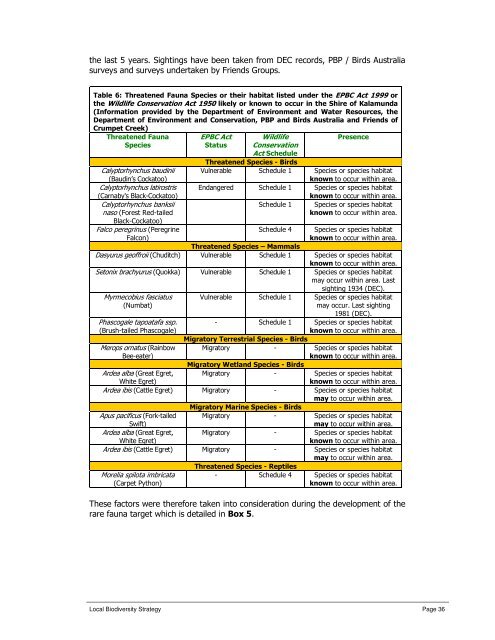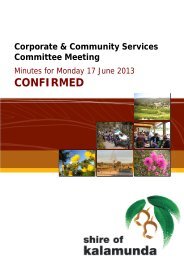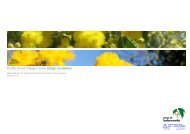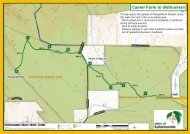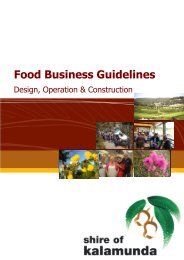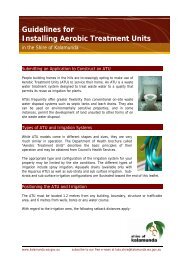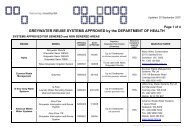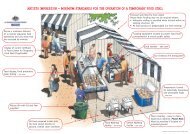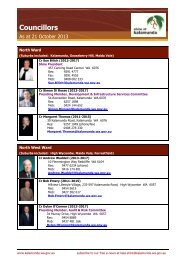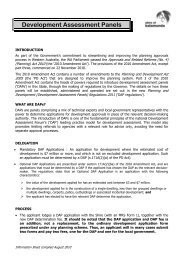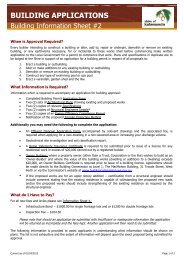Local Biodiversity Strategy: - Shire of Kalamunda
Local Biodiversity Strategy: - Shire of Kalamunda
Local Biodiversity Strategy: - Shire of Kalamunda
Create successful ePaper yourself
Turn your PDF publications into a flip-book with our unique Google optimized e-Paper software.
the last 5 years. Sightings have been taken from DEC records, PBP / Birds Australia<br />
surveys and surveys undertaken by Friends Groups.<br />
Table 6: Threatened Fauna Species or their habitat listed under the EPBC Act 1999 or<br />
the Wildlife Conservation Act 1950 likely or known to occur in the <strong>Shire</strong> <strong>of</strong> <strong>Kalamunda</strong><br />
(Information provided by the Department <strong>of</strong> Environment and Water Resources, the<br />
Department <strong>of</strong> Environment and Conservation, PBP and Birds Australia and Friends <strong>of</strong><br />
Crumpet Creek)<br />
Threatened Fauna<br />
Species<br />
EPBC Act<br />
Status<br />
Wildlife<br />
Conservation<br />
Act Schedule<br />
Presence<br />
Threatened Species - Birds<br />
Calyptorhynchus baudinii<br />
(Baudin’s Cockatoo)<br />
Vulnerable Schedule 1 Species or species habitat<br />
known to occur within area.<br />
Calyptorhynchus latirostris<br />
(Carnaby's Black-Cockatoo)<br />
Endangered Schedule 1 Species or species habitat<br />
known to occur within area.<br />
Calyptorhynchus banksii<br />
naso (Forest Red-tailed<br />
Schedule 1 Species or species habitat<br />
known to occur within area.<br />
Black-Cockatoo)<br />
Falco peregrinus (Peregrine<br />
Falcon)<br />
Schedule 4 Species or species habitat<br />
known to occur within area.<br />
Threatened Species – Mammals<br />
Dasyurus ge<strong>of</strong>froii (Chuditch) Vulnerable Schedule 1 Species or species habitat<br />
known to occur within area.<br />
Setonix brachyurus (Quokka) Vulnerable Schedule 1 Species or species habitat<br />
may occur within area. Last<br />
sighting 1934 (DEC).<br />
Myrmecobius fasciatus<br />
(Numbat)<br />
Phascogale tapoatafa ssp.<br />
(Brush-tailed Phascogale)<br />
Merops ornatus (Rainbow<br />
Bee-eater)<br />
Vulnerable Schedule 1 Species or species habitat<br />
may occur. Last sighting<br />
1981 (DEC).<br />
- Schedule 1 Species or species habitat<br />
known to occur within area.<br />
Migratory Terrestrial Species - Birds<br />
Migratory - Species or species habitat<br />
known to occur within area.<br />
Migratory Wetland Species - Birds<br />
Migratory - Species or species habitat<br />
known to occur within area.<br />
Ardea alba (Great Egret,<br />
White Egret)<br />
Ardea ibis (Cattle Egret) Migratory - Species or species habitat<br />
may to occur within area.<br />
Migratory Marine Species - Birds<br />
Apus pacificus (Fork-tailed<br />
Swift)<br />
Migratory - Species or species habitat<br />
may to occur within area.<br />
Ardea alba (Great Egret,<br />
White Egret)<br />
Migratory - Species or species habitat<br />
known to occur within area.<br />
Ardea ibis (Cattle Egret) Migratory - Species or species habitat<br />
may to occur within area.<br />
Threatened Species - Reptiles<br />
Morelia spilota imbricata<br />
(Carpet Python)<br />
- Schedule 4 Species or species habitat<br />
known to occur within area.<br />
These factors were therefore taken into consideration during the development <strong>of</strong> the<br />
rare fauna target which is detailed in Box 5.<br />
<strong>Local</strong> <strong>Biodiversity</strong> <strong>Strategy</strong> Page 36


